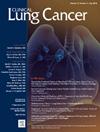The Potential of Basal F-18-FDG PET/CT in Evaluating Prognosis and Benefit From Adjuvant Chemotherapy After Tumor Resection of Stage IB(T2, ≤ 3 cm With VPI, N0, M0)NSCLC
IF 3.3
3区 医学
Q2 ONCOLOGY
引用次数: 0
Abstract
Objectives
To investigated whether the basal F-18-FDG PET/CT could evaluate the prognosis or the benefit from adjuvant chemotherapy after surgery of patients with early-stage NSCLC with visceral pleural invasion.
Materials and Methods
A total of 116 patients with stage IB (T2, ≤ 3 cm with VPI, N0, M0) NSCLC underwent tumor resection and F-18-FDG PET/CT 1-3 weeks before surgery and were followed up for 1-79 months after surgery. SUVpeak, SUVmax, SUVmean, MTV, and TLG of tumors were obtained. The primary and secondary endpoints were progression-free survival (PFS) and overall survival (OS), respectively. ROC curve analysis, Cox regression test, and the Kaplan-Meier method were used for statistical analysis.
Results
High SUVs, TLG, and MTV were associated with postoperative progression of NSCLC (the area under the ROC curve: 0.695 to 0.750, P < .001). The increase of SUVs, TLG or MTV was associated with short postoperative PFS (P < .001) while an increase in TLG (P = .016) or MTV (P = .018) was associated with short postoperative OS. TLG > 16.81 was an independent indicator of both the short PFS (HR = 5.534, P = .002) and the short OS (HR = 5.075, P = .031). Further, adjuvant chemotherapy was associated with longer PFS in NSCLCs with TLG > 16.81 (treated vs. untreated: 63 vs. 52 months; HR = 2.242, P = .022) rather than those with TLG ≤ 16.81.
Conclusion
SUV-based parameters on F-18-FDG PET/CT have the potential to evaluate the prognosis and benefit from adjuvant chemotherapy after tumor resection in stage IB (T2, ≤ 3 cm with VPI, N0, M0) NSCLC and therefore may be helpful for lung cancer treatment.
基础F-18-FDG PET/CT评价IB期(T2,≤3cm伴VPI, N0, M0)非小细胞肺癌肿瘤切除后辅助化疗预后和获益的潜力
目的:探讨基础F-18-FDG PET/CT对早期非小细胞肺癌内脏性胸膜侵犯患者术后辅助化疗的预后和获益评价。材料与方法:116例IB期(T2,≤3cm, VPI, N0, M0)非小细胞肺癌患者术前1-3周行肿瘤切除及F-18-FDG PET/CT,术后随访1-79个月。计算肿瘤的SUVpeak、SUVmax、SUVmean、MTV、TLG。主要终点和次要终点分别是无进展生存期(PFS)和总生存期(OS)。采用ROC曲线分析、Cox回归检验和Kaplan-Meier法进行统计分析。结果:高suv、TLG、MTV与NSCLC术后进展相关(ROC曲线下面积:0.695 ~ 0.750,P < 0.001)。suv、TLG或MTV的增加与术后较短的PFS相关(P < 0.001),而TLG (P = 0.016)或MTV (P = 0.018)的增加与术后较短的OS相关。TLG > 16.81是短PFS (HR = 5.534, P = 0.002)和短OS (HR = 5.075, P = 0.031)的独立指标。此外,辅助化疗与TLG患者较长的PFS相关(治疗vs.未治疗:63 vs. 52个月;HR = 2.242, P = 0.022),而TLG≤16.81者较低。结论:F-18-FDG PET/CT上基于suv的参数有可能评估IB期(T2,≤3cm伴VPI, N0, M0)非小细胞肺癌术后辅助化疗的预后和获益,因此可能有助于肺癌的治疗。
本文章由计算机程序翻译,如有差异,请以英文原文为准。
求助全文
约1分钟内获得全文
求助全文
来源期刊

Clinical lung cancer
医学-肿瘤学
CiteScore
7.00
自引率
2.80%
发文量
159
审稿时长
24 days
期刊介绍:
Clinical Lung Cancer is a peer-reviewed bimonthly journal that publishes original articles describing various aspects of clinical and translational research of lung cancer. Clinical Lung Cancer is devoted to articles on detection, diagnosis, prevention, and treatment of lung cancer. The main emphasis is on recent scientific developments in all areas related to lung cancer. Specific areas of interest include clinical research and mechanistic approaches; drug sensitivity and resistance; gene and antisense therapy; pathology, markers, and prognostic indicators; chemoprevention strategies; multimodality therapy; and integration of various approaches.
 求助内容:
求助内容: 应助结果提醒方式:
应助结果提醒方式:


